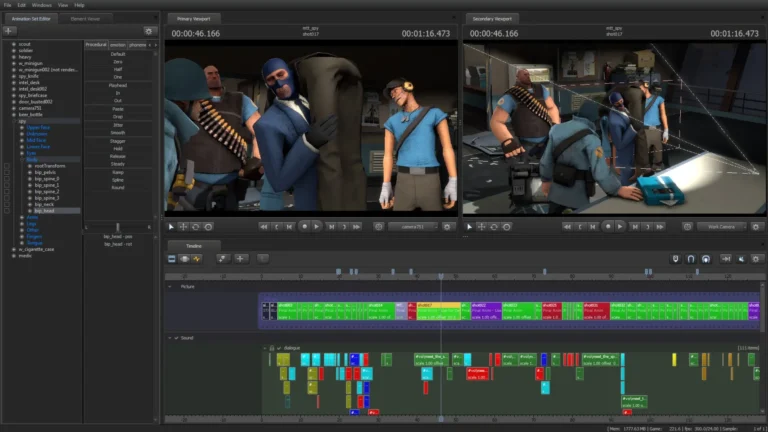Fixing Common SFM Compile Errors Rendering Like a Pro in Source Filmmaker
Source Filmmaker (SFM Compile) is a powerful tool that allows creators to bring their ideas to life using the Source engine. Whether you’re an animator, machinima creator, or just someone experimenting with 3D animation, the process of compiling your SFM project is an essential part of the workflow. However, as with any complex software, users often encounter a variety of issues during the compile phase, causing frustration and slowing down the production process. In this article, we’ll explore common SFM compile errors and provide solutions so you can render your SFM projects like a pro.
Understanding SFM Compile: What Is It?
Before diving into the errors, it’s essential to understand what the term “SFM compile” refers to. Compiling in SFM involves taking all the assets and data from a Source Filmmaker project and converting them into a format that can be rendered into a final video or animation. This process is similar to how a computer compiles code into an executable file; it assembles all the components (models, animations, lighting, etc.) into a cohesive scene that can be viewed and edited.
The compile process can be quite resource-intensive, depending on the complexity of your scene, the number of assets used, and the rendering settings. However, if something goes wrong during the compilation, it can cause errors that interrupt your workflow. Understanding these errors and how to fix them is crucial for a smooth production process.
Common SFM Compile Errors and How to Fix Them
1. Missing Models or Textures (Error: “Model Not Found”)
One of the most common errors you might encounter when compiling in SFM is the “model not found” error. This happens when SFM can’t locate a model or texture that your scene relies on. This can be due to several reasons, such as incorrect file paths, missing files, or improper installation of custom assets.
Fixing Missing Models or Textures
- Check File Paths: Ensure that all model and texture files are located in the correct directories. SFM looks for assets in specific folders, and if these are misplaced, it won’t be able to find them.
- Verify Asset Installation: If you’re using custom models or textures, make sure they were installed correctly. Often, users forget to extract files properly or place them in the wrong directory. Ensure that models are placed in the
modelsfolder and textures in thematerialsfolder. - Reimport the Model: Sometimes, simply reimporting the model into your SFM project can resolve the issue. This forces SFM to re-scan the asset and its corresponding files.
2. SFM Compile Freezes or Crashes
Another frustrating issue that users frequently encounter is SFM Compile freezing or crashing during the compile process. This can occur due to a variety of reasons, such as hardware limitations, corrupted files, or conflicts between assets.
Fixing SFM Compile Freezes or Crashes
- Increase Virtual Memory: If you’re working with complex scenes, SFM may require more virtual memory than your system is currently allowing. Increase the virtual memory allocation on your computer to give SFM more resources.
- Check for Corrupt Assets: Corrupted models, textures, or animations can cause SFM to freeze. Try isolating the problem by disabling certain assets one by one and compiling again. If the issue goes away, you’ve identified the problematic asset.
- Update Drivers: Outdated graphics drivers can cause crashes and rendering issues. Make sure your GPU drivers are up to date to ensure optimal performance.
3. Animation Errors (Error: “Invalid Sequence”)
Animation errors in SFM can be particularly troublesome, especially if you’re working with multiple character animations and complex sequences. The “invalid sequence” error typically occurs when the system is unable to properly load or process an animation file.
Fixing Animation Errors
- Check Animation Files: Ensure that the animation files you’re using are compatible with the model and the scene. Some animations are specific to certain models, and using the wrong type can result in errors.
- Rebuild the Animation: If the animation file is corrupt, try creating a new animation from scratch or importing a new version of the animation. Sometimes, re-exporting the animation from the software you created it in (such as Blender or Maya) can resolve the issue.
- Verify Sequence Naming: SFM relies on specific naming conventions for animation sequences. Ensure that the sequences are correctly named and properly linked to the corresponding models in your project.
4. Lighting and Shadow Errors
Lighting and shadow issues are common when compiling in SFM. These errors can cause your scene to look unnatural or fail to compile entirely. Issues can arise from incorrect lighting setups, missing shadow data, or conflicts between light sources and materials.
Fixing Lighting and Shadow Errors
- Check Light Source Placement: Ensure that light sources are properly placed in the scene and have the correct properties (intensity, color, etc.). Sometimes, light sources placed too close to objects or in awkward positions can cause rendering issues.
- Adjust Shadow Settings: If shadows are causing errors, try adjusting the shadow quality settings in the SFM Compile render settings. Lowering the shadow quality can help alleviate performance issues, while increasing it may give you more realistic shadows.
- Disable Conflicting Lights: Too many light sources or conflicting lighting can cause shadows to behave erratically. Disable unnecessary light sources and re-test your scene.
5. Compile Error: “Texture Not Found”
The “texture not found” error occurs when SFM cannot locate a texture that is being applied to a model or prop. This can happen if the texture file is missing, incorrectly named, or placed in the wrong directory.
Fixing Texture Not Found Errors
- Verify Texture File Locations: Check that all texture files are in the correct directories, typically located in the
materialsfolder. If the texture is located elsewhere, SFM won’t be able to find it during the compile process. - Reassign the Texture: Sometimes, SFM may fail to properly link the texture to the model. Try reassigning the texture to the model or prop in the SFM editor.
- Ensure Correct File Formats: SFM requires textures to be in specific file formats (such as
.vtf). If you’re using a different file format, SFM may not recognize it, leading to compile errors.
6. SFM Compile Error: “Out of Memory”
An “out of memory” error is typically associated with large or complex projects. SFM may exceed your system’s available RAM or virtual memory, causing the compile process to fail.
Fixing Out of Memory Errors
- Optimize Your Scene: Reduce the number of assets, lights, and models in your scene. Simplify the project by removing unnecessary elements that might be consuming too much memory.
- Upgrade Your Hardware: If you’re consistently hitting memory limits, it might be time to consider upgrading your RAM or GPU. SFM relies heavily on system resources, especially for large-scale projects.
- Increase SFM’s Memory Usage: Adjust SFM’s memory settings in the configuration files to allow it to utilize more of your system’s available resources.
Advanced Tips for SFM Compile Success
1. Organize Your Assets Properly
Proper asset management is key to avoiding compile errors in SFM. Always ensure that your models, textures, and animations are stored in the correct directories. This will make it easier for SFM to locate them during the compile process.
2. Regularly Save and Backup Your Project
Before starting the compile process, make sure to save and backup your project. SFM Compile can occasionally crash or encounter errors during compilation, and having a backup ensures you won’t lose any progress.
3. Use the Latest Version of SFM
Always update to the latest version of Source Filmmaker to take advantage of bug fixes, performance improvements, and new features. Older versions of SFM may have known bugs that can interfere with compiling your project.
4. Check SFM Console for Detailed Error Messages
When an error occurs, the SFM console often provides detailed error messages that can point you in the right direction. Pay close attention to these messages as they can help you identify missing assets, conflicts, or other issues.
Conclusion: Rendering Like a Pro in SFM
SFM Compile is an incredible tool for animators and creators, but like any software, it can come with its share of challenges. By understanding the common compile errors and knowing how to troubleshoot them, you can overcome these obstacles and continue creating your masterpiece. Whether you’re dealing with missing textures, animation issues, or memory errors, the solutions outlined in this article should help you fix the problems and get back to rendering your SFM projects like a pro.
Remember to stay organized, update your software, and always keep backups of your work to minimize potential issues during the compile process. With practice and patience, you’ll be able to master the art of compiling in Source Filmmaker and create stunning animations and videos with ease.
How to Compile in Source Filmmaker (SFM): A Beginner’s Guide




